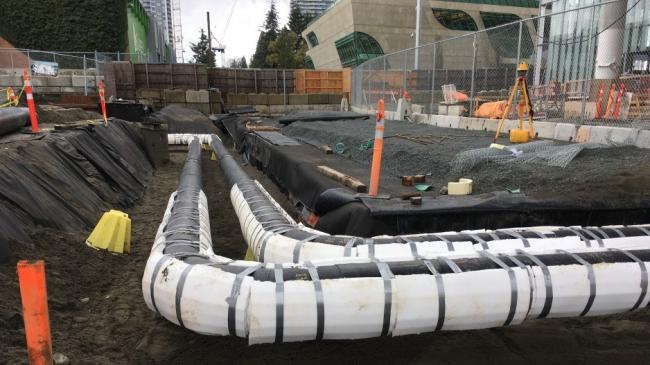Articles Menu

Mar. 8, 2021
Every day, vast amounts of heat generated from industry, data centres and hockey rinks is just wasted.
When the source of waste heat is close enough, it can be tapped and piped into a building or a district energy system.
Clearly, it’s not feasible to run pipes from a cement plant in East Richmond, an oil refinery in Burnaby or a big data centre in Kelowna all the way to a district energy system in Vancouver or Surrey.
But what if it could be stored and transported by truck?
Engineers at Simon Fraser University (SFU) think mobile thermal heat delivery could be a thing. They calculate that six mobile heat tanks delivered by truck each day could supply 40% of the Surrey district energy system’s peak heating needs.
With support and funding from the City of Surrey, CanmetEnergy and the Pacific Institute for Climate Solutions (PICS), they have been developing a mobile thermal battery that they call a Mobile Thermal Energy Storage (M-TES) that uses a thermochemical solution that can store latent heat for long periods of time so that it can be transported and discharged.
“This project, in a nutshell, is why don’t we harvest the heat and store it, and bring it to this district energy network,” said Majid Bahrami, an engineer who leads the project and research team at SFU’s Laboratory for Alternative Energy Conversion.
Surrey’s district energy network burns natural gas to provide heat to the buildings that are connected to it. The idea is to use captured waste heat to reduce the district energy system’s use of natural gas, and therefore shrink its carbon footprint.
The heat generated in some industrial processes, data centres and ice rinks is wasted. Using heat exchangers, that heat could be tapped and put into a mobile storage tank filled with solutions that can store energy chemically.
Don’t think of it as a big mobile thermos bottle filled with hot liquid, but more like a battery that is “charged” with latent heat energy and later “discharged” when it reacts with water.
The heat is not stored as "sensible" heat, but rather is stored chemically when certain chemical solutions undergo a reaction.
Bahrami has been experimenting with compounds like lithium-bromide and lithium-chloride. Basically, their chemistry changes when heated. When the process is reversed, the heat is released.
“The reaction products are then separated, and mixed again when heat is required on demand, resulting in a release of energy at the district energy network at Surrey in our current project for example,” Bahrami explaind.
“If we add water to this liquid, it becomes hot. Water vapour is the agent that activates the reaction.”
Waste heat would be captured at a hockey rink or petrochemical plant and it would "charge" a mobile tank left on site. When the tank is fully charged, it would be replaced with a discharged tank, and the charged tank would be taken to the Surrey district energy system.
The mobile thermal battery system, which has been dubbed "heat on wheels" is still in the early stages of development.
“We are very close to build a pre-market prototype,” Bahrami said.
Bahrami is hoping to find a private sector partner to work with that would provide the waste heat.
[Top photo: Surrey's District Energy Network uses pipes like these to carry hot water to buildings. Submitted]